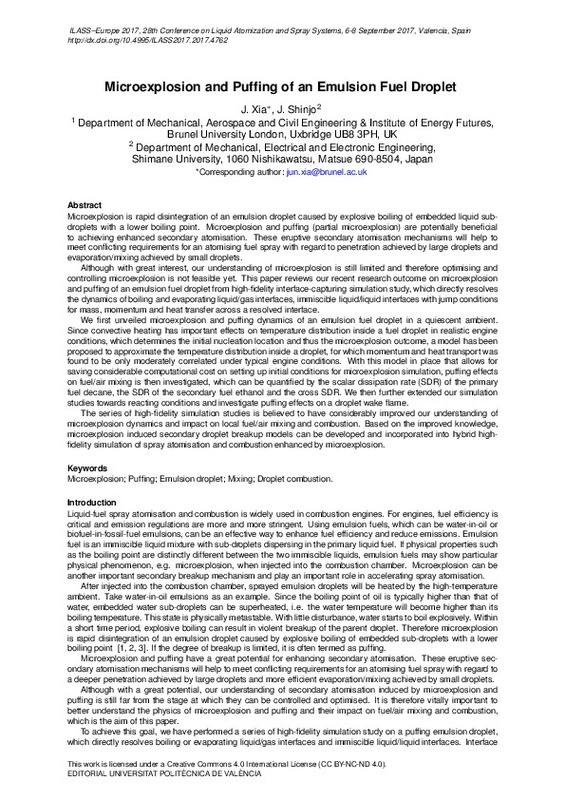JavaScript is disabled for your browser. Some features of this site may not work without it.
Buscar en RiuNet
Listar
Mi cuenta
Estadísticas
Ayuda RiuNet
Admin. UPV
Microexplosion and Puffing of an Emulsion Fuel Droplet
Mostrar el registro sencillo del ítem
Ficheros en el ítem
| dc.contributor.author | Xia, Jun
|
es_ES |
| dc.contributor.author | Shinjo, Junji
|
es_ES |
| dc.date.accessioned | 2018-04-12T11:00:27Z | |
| dc.date.available | 2018-04-12T11:00:27Z | |
| dc.date.issued | 2017-07-28 | |
| dc.identifier.isbn | 9788490485804 | |
| dc.identifier.uri | http://hdl.handle.net/10251/100296 | |
| dc.description.abstract | [EN] Microexplosion is rapid disintegration of an emulsion droplet caused by explosive boiling of embedded liquid subdroplets with a lower boiling point. Microexplosion and puffing (partial microexplosion) are potentially beneficial to achieving enhanced secondary atomisation. These eruptive secondary atomisation mechanisms will help to meet conflicting requirements for an atomising fuel spray with regard to penetration achieved by large droplets and evaporation/mixing achieved by small droplets. Although with great interest, our understanding of microexplosion is still limited and therefore optimising and controlling microexplosion is not feasible yet. This paper reviews our recent research outcome on microexplosion and puffing of an emulsion fuel droplet from high-fidelity interface-capturing simulation study, which directly resolves the dynamics of boiling and evaporating liquid/gas interfaces, immiscible liquid/liquid interfaces with jump conditions for mass, momentum and heat transfer across a resolved interface. We first unveiled microexplosion and puffing dynamics of an emulsion fuel droplet in a quiescent ambient. Since convective heating has important effects on temperature distribution inside a fuel droplet in realistic engine conditions, which determines the initial nucleation location and thus the microexplosion outcome, a model has been proposed to approximate the temperature distribution inside a droplet, for which momentum and heat transport was found to be only moderately correlated under typical engine conditions. With this model in place that allows for saving considerable computational cost on setting up initial conditions for microexplosion simulation, puffing effects on fuel/air mixing is then investigated, which can be quantified by the scalar dissipation rate (SDR) of the primary fuel decane, the SDR of the secondary fuel ethanol and the cross SDR. We then further extended our simulation studies towards reacting conditions and investigate puffing effects on a droplet wake flame. The series of high-fidelity simulation studies is believed to have considerably improved our understanding of microexplosion dynamics and impact on local fuel/air mixing and combustion. Based on the improved knowledge, microexplosion induced secondary droplet breakup models can be developed and incorporated into hybrid highfidelity simulation of spray atomisation and combustion enhanced by microexplosion. | es_ES |
| dc.description.sponsorship | The authors are grateful for the financial support of the Engineering and Physical Sciences Research Council (EPSRC) of the UK under Grant No. EP/J018023/1. | es_ES |
| dc.format.extent | 8 | es_ES |
| dc.language | Inglés | es_ES |
| dc.publisher | Editorial Universitat Politècnica de València | es_ES |
| dc.relation.ispartof | Ilass Europe. 28th european conference on Liquid Atomization and Spray Systems | es_ES |
| dc.rights | Reconocimiento - No comercial - Sin obra derivada (by-nc-nd) | es_ES |
| dc.subject | Microexplosion | es_ES |
| dc.subject | Puffing | es_ES |
| dc.subject | Emulsion droplet | es_ES |
| dc.subject | Mixing | es_ES |
| dc.subject | Droplet combustion | es_ES |
| dc.title | Microexplosion and Puffing of an Emulsion Fuel Droplet | es_ES |
| dc.type | Capítulo de libro | es_ES |
| dc.type | Comunicación en congreso | es_ES |
| dc.identifier.doi | 10.4995/ILASS2017.2017.4762 | |
| dc.relation.projectID | info:eu-repo/grantAgreement/UKRI//EP%2FJ018023%2F1/GB/Micro-explosion of Fuel Blends in Low Carbon Diesel Engines: Experimental and Modelling Study/ | es_ES |
| dc.rights.accessRights | Abierto | es_ES |
| dc.description.bibliographicCitation | Xia, J.; Shinjo, J. (2017). Microexplosion and Puffing of an Emulsion Fuel Droplet. En Ilass Europe. 28th european conference on Liquid Atomization and Spray Systems. Editorial Universitat Politècnica de València. 432-439. https://doi.org/10.4995/ILASS2017.2017.4762 | es_ES |
| dc.description.accrualMethod | OCS | es_ES |
| dc.relation.conferencename | ILASS2017 - 28th European Conference on Liquid Atomization and Spray Systems | es_ES |
| dc.relation.conferencedate | September 06-08,2017 | es_ES |
| dc.relation.conferenceplace | Valencia, Spain | es_ES |
| dc.relation.publisherversion | http://ocs.editorial.upv.es/index.php/ILASS/ILASS2017/paper/view/4762 | es_ES |
| dc.description.upvformatpinicio | 432 | es_ES |
| dc.description.upvformatpfin | 439 | es_ES |
| dc.type.version | info:eu-repo/semantics/publishedVersion | es_ES |
| dc.relation.pasarela | OCS\4762 | es_ES |
| dc.contributor.funder | Engineering and Physical Sciences Research Council, Reino Unido | |
| dc.contributor.funder | UK Research and Innovation | es_ES |








